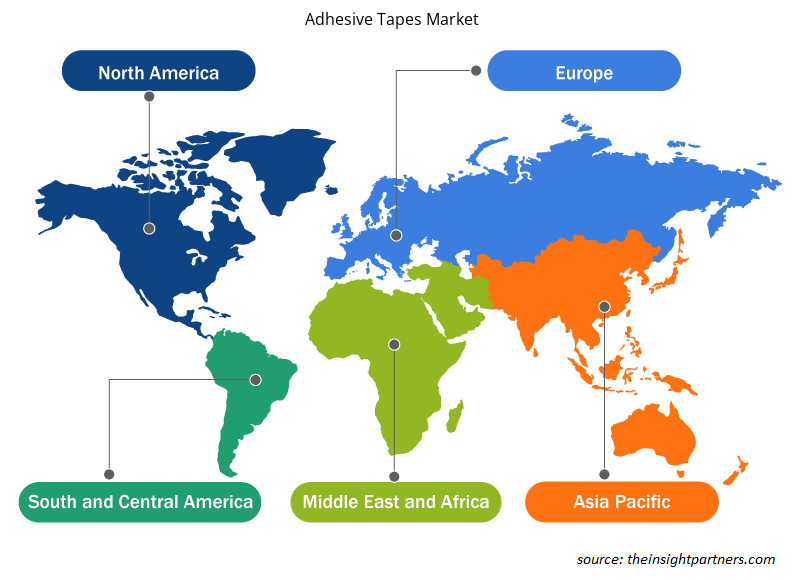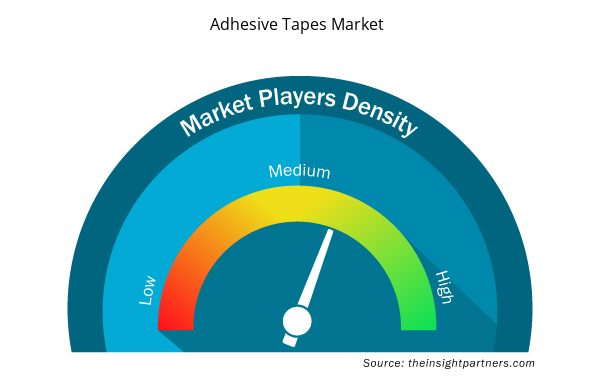2020 年胶带市场价值为 609.2261 亿美元,预计到 2028 年将达到 894.4092 亿美元;预计 2021 年至 2028 年的复合年增长率为 5.1%。
胶带有两种类型:特种胶带和商品胶带。胶带中使用的涂层技术包括水基、溶剂基和热熔。近年来,技术进步导致对轻质背衬材料的需求不断增长。胶带在包装、汽车和医疗保健行业有着广泛的应用。
2020 年,亚太地区占据全球胶带市场的最大份额。预计在预测期内,该地区的复合年增长率也将最高。由于人口基数庞大、可支配收入增加和生活水平提高等各种因素,该地区对胶带的需求预计将增加。汽车市场的增长也推动了亚太地区对胶带的需求。这些因素还吸引了外国企业在该地区拓展业务。此外,亚太地区的快速增长归因于该地区建筑业的增长。中国是世界上最大的建筑市场,预计未来几年将大幅增长。此外,印度等其他经济体也将以惊人的速度增长,重点是促进国内制造业活动。
COVID-19 疫情对全球胶带市场的影响喜忧参半。汽车、建筑、电子和电气等各个行业都经历了急剧下滑。相比之下,由于对 PPE 套件和医疗设备的需求过大,自疫情爆发以来,医疗保健行业一直在增长。随着经济复苏,多个行业和经济体正在战略性地计划投资医疗保健领域。预计这将推动胶带市场的增长。与健康相关的举措包括购买专业医疗和个人防护设备 (PPE)、扩大研究能力、雇用更多员工和福利、支持医院和地方政府以及捐赠疫苗生产。此外,3M Company、Tesa SE 和 Nitto Denko Corporation 等许多公司已开始积极营销该产品,以扩大客户群并减少业务影响。
定制此报告以满足您的需求
您可以免费定制任何报告,包括本报告的部分内容、国家级分析、Excel 数据包,以及为初创企业和大学提供优惠和折扣
- 获取此报告的关键市场趋势。这个免费样品将包括数据分析,从市场趋势到估计和预测。
市场洞察
胶带的广泛应用
胶带是材料和胶膜的组合,用于粘合或连接物体,而不是使用螺钉、紧固件或焊接。胶带无需紧固件或螺钉即可保护表面,因此可用于包装、医疗保健、汽车、电气和电子以及建筑和施工等行业的各种应用。液体粘合剂麻烦且耗时,因为必须在粘合前将其喷洒或滚涂在表面上。胶带在包装、医疗保健、汽车、电气和电子以及建筑和施工等行业中具有广泛的应用。
应用程序洞察
根据应用,全球胶带市场细分为包装、医疗保健、汽车、电气和电子、建筑和施工等。汽车行业在 2020 年引领了市场。胶带在汽车领域有多种应用。在车辆内部,胶带用于座椅加热元件、安全气囊包裹和固定、方向盘包裹、橡胶安装、塑料型材以及仪表板上的泡沫和织物附件。在具有移动设备附件、电子充电器、空气净化器、便携式冰柜连接和其他组件等功能的汽车内饰中,胶带用于紧固和粘合目的。此外,它们还用于开发汽车电子产品,例如灯组件、空调系统、电子显示面板、电池连接器和电线以及传感器。此外,胶带正在迅速取代螺母螺栓紧固件,以减轻车辆重量并增强车辆美观。车辆对轻量化密封的需求不断增长以及电动汽车制造中胶带使用量的增加预计将在未来几年推动胶带市场的增长。
胶带市场的一些主要市场参与者包括 3M、Nitto Denko Corporation、tesa SE、Avery Dennison Corporation、Intertape Polymer Group、LINTEC Corporation、Berry Global Inc、Scapa、Lohmann GmbH & Co.KG 和 Rogers Corporation。
报告亮点
- 全球胶带市场的渐进式行业趋势可帮助参与者制定有效的长期战略
- 发达市场和发展中市场采用的业务增长战略
- 2019 年至 2028 年全球胶带市场定量分析
- 各行业对胶带的需求估计
- PEST 分析说明行业内买家和供应商预测市场增长的有效性
- 了解竞争激烈的市场形势和胶带需求的最新发展
- 市场趋势和前景,以及推动和抑制胶带市场增长的因素
- 通过了解支撑全球胶带市场增长商业利益的战略来制定决策过程
- 不同市场节点的胶带市场规模
- 全球胶带市场的详细概述和细分,以及行业动态
- 各地区胶带市场规模及增长机遇
报告对全球胶带市场进行如下细分:
- 根据树脂类型,胶带市场分为丙烯酸胶带、橡胶胶带、硅胶胶带和其他胶带。
- 根据技术,胶带市场分为水基胶带、溶剂型胶带和热熔型胶带。
- 根据胶带基材,胶带市场分为聚丙烯 (PP)、纸、聚氯乙烯 (PVC)、其他。
- 根据应用,胶带市场分为包装、医疗保健、汽车、电气和电子、建筑和施工、其他。
胶带市场区域洞察
Insight Partners 的分析师已详尽解释了预测期内影响胶带市场的区域趋势和因素。本节还讨论了北美、欧洲、亚太地区、中东和非洲以及南美和中美洲的胶带市场细分和地理位置。

- 获取胶带市场的区域特定数据
胶带市场报告范围
| 报告属性 | 细节 |
|---|---|
| 2020 年市场规模 | 609.2亿美元 |
| 2028 年市场规模 | 894.4亿美元 |
| 全球复合年增长率(2020 - 2028) | 5.1% |
| 史料 | 2018-2019 |
| 预测期 | 2021-2028 |
| 涵盖的领域 | 按树脂类型
|
| 覆盖地区和国家 | 北美
|
| 市场领导者和主要公司简介 |
|
胶带市场参与者密度:了解其对业务动态的影响
胶带市场正在快速增长,这得益于终端用户需求的不断增长,而这些需求又源于消费者偏好的不断变化、技术进步以及对产品优势的认识不断提高等因素。随着需求的增加,企业正在扩大其产品范围,进行创新以满足消费者的需求,并利用新兴趋势,从而进一步推动市场增长。
市场参与者密度是指在特定市场或行业内运营的企业或公司的分布情况。它表明在给定市场空间中,相对于其规模或总市场价值,有多少竞争对手(市场参与者)存在。
在胶带市场运营的主要公司有:
- 3M 公司
- 日东电工株式会社
- 德莎
- 琳得科株式会社
- 艾利丹尼森公司
免责声明:上面列出的公司没有按照任何特定顺序排列。

- 了解胶带市场主要参与者概况
公司简介
- 3M
- 日东电工株式会社
- 德莎
- 艾利丹尼森公司
- 国际胶带聚合物集团
- 琳得科株式会社
- 贝瑞全球公司
- 斯卡帕
- 罗曼有限公司
- 罗杰斯公司
- 历史分析(2 年)、基准年、预测(7 年)及复合年增长率
- PEST 和 SWOT 分析
- 市场规模价值/数量 - 全球、区域、国家
- 行业和竞争格局
- Excel 数据集


- Piling Machines Market
- Rugged Servers Market
- Hot Melt Adhesives Market
- Vaginal Specula Market
- Biopharmaceutical Contract Manufacturing Market
- Social Employee Recognition System Market
- Small Internal Combustion Engine Market
- EMC Testing Market
- Fertilizer Additives Market
- Public Key Infrastructure Market

Report Coverage
Revenue forecast, Company Analysis, Industry landscape, Growth factors, and Trends

Segment Covered
This text is related
to segments covered.

Regional Scope
North America, Europe, Asia Pacific, Middle East & Africa, South & Central America

Country Scope
This text is related
to country scope.
常见问题
Packaging is estimated to register the fastest CAGR in the market over the forecast period. Adhesive tapes are extensively used across the packaging industry. Adhesive tapes secure the packages as it forms a strong bond between the packaging surfaces. Cartons of food and beverages products are sealed using adhesive tapes as they ensure products’ safety in transit. Moreover, adhesive tapes are used to seal the packages of agricultural products. The packaging industry across the world is rapidly flourishing with the growing demand for convenience food products, agriculture products, and other consumer goods.
On the basis of tape backing material, polypropylene (PP) segment is leading the adhesive tapes market during the forecast period. Polypropylene is widely used as a backing material in adhesive tapes. Backing film is one of the vital components of an adhesive tape. It holds the adhesive and the primer. Polypropylene is a thermally and chemically stable material. It provides surface protection. Moreover, polypropylene is comparatively cheaper than polyvinyl chloride (PVC) and is widely available. These properties make polypropylene one of the popular materials used for manufacturing adhesive tapes. Polypropylene tapes are suitable for a wide range of sealing applications, such as food & beverage packaging, agricultural packaging, and healthcare and medical packaging.
The hot-melt adhesives segment is expected to grow at the fastest rate during the forecast period. Hot-melt adhesives are thermoplastic polymer-based compositions that are 100% solids. They are solid at normal temperature and become liquid after being heated above their softening point. Hot-melt-based adhesive tapes consist of three layers—film layer, a special release coat that allows the tape to easily unwind off the roll, and an aggressive hot-melt adhesive layer. These tapes are used for various applications, such as furniture and wood working, packaging and corrugated carton sealing, DIY applications, and building & construction.
The rubber segment held the largest share in the global adhesive tapes market in 2020. Rubber adhesives are low-cost adhesives used to manufacture adhesive tapes that are used for low-duty applications. Rubber adhesives adhere to the substrates quickly and do not require extended cure times. Generally, additives are added to rubber adhesives to improve their adhesion strength. Rubber adhesives perform better in normal room temperatures.
The major key players operating in the global adhesive tapes market include 3M, Nitto Denko Corporation, tesa SE, Avery Dennison Corporation, Intertape Polymer Group, LINTEC Corporation, Berry Global Inc., Scapa, Lohmann GmbH & Co.KG, and Rogers Corporation are major players operating in the global adhesive tapes market.
In 2020, Asia Pacific held the largest share of the global adhesive tapes market. It is also estimated to register the fastest CAGR in the market over the forecast period. The demand for adhesive tapes is expected to increase in the region due to various factors such as the huge population base, increasing disposable income, and improved living standards. The growth of the automotive market has also positively contributed to the growth of the demand for adhesive tapes in Asia Pacific. These factors have also attracted foreign players to expand into the region.
Additionally, the rapid growth of this region can also be attributed to the growth of the construction industry in the region. China is the world’s largest construction market and is expected to grow significantly over the next few years. Moreover, other developing economies like India is also set to grow at a tremendous rate with the focus of the region towards boosting domestic manufacturing activities.
Trends and growth analysis reports related to Chemicals and Materials : READ MORE..
The List of Companies - Adhesive Tapes Market
- 3M COMPANY
- NITTO DENKO CORPORATION
- TESA SE
- LINTEC CORPORATION
- AVERY DENNISON CORPORATION
- INTERTAPE POLYMER GROUP
- BERRY GLOBAL INC.
- SCAPA GROUP PLC
- LOHMANN GMBH AND CO.KG
- ROGERS CORPORATION
The Insight Partners performs research in 4 major stages: Data Collection & Secondary Research, Primary Research, Data Analysis and Data Triangulation & Final Review.
- Data Collection and Secondary Research:
As a market research and consulting firm operating from a decade, we have published and advised several client across the globe. First step for any study will start with an assessment of currently available data and insights from existing reports. Further, historical and current market information is collected from Investor Presentations, Annual Reports, SEC Filings, etc., and other information related to company’s performance and market positioning are gathered from Paid Databases (Factiva, Hoovers, and Reuters) and various other publications available in public domain.
Several associations trade associates, technical forums, institutes, societies and organization are accessed to gain technical as well as market related insights through their publications such as research papers, blogs and press releases related to the studies are referred to get cues about the market. Further, white papers, journals, magazines, and other news articles published in last 3 years are scrutinized and analyzed to understand the current market trends.
- Primary Research:
The primarily interview analysis comprise of data obtained from industry participants interview and answers to survey questions gathered by in-house primary team.
For primary research, interviews are conducted with industry experts/CEOs/Marketing Managers/VPs/Subject Matter Experts from both demand and supply side to get a 360-degree view of the market. The primary team conducts several interviews based on the complexity of the markets to understand the various market trends and dynamics which makes research more credible and precise.
A typical research interview fulfils the following functions:
- Provides first-hand information on the market size, market trends, growth trends, competitive landscape, and outlook
- Validates and strengthens in-house secondary research findings
- Develops the analysis team’s expertise and market understanding
Primary research involves email interactions and telephone interviews for each market, category, segment, and sub-segment across geographies. The participants who typically take part in such a process include, but are not limited to:
- Industry participants: VPs, business development managers, market intelligence managers and national sales managers
- Outside experts: Valuation experts, research analysts and key opinion leaders specializing in the electronics and semiconductor industry.
Below is the breakup of our primary respondents by company, designation, and region:

Once we receive the confirmation from primary research sources or primary respondents, we finalize the base year market estimation and forecast the data as per the macroeconomic and microeconomic factors assessed during data collection.
- Data Analysis:
Once data is validated through both secondary as well as primary respondents, we finalize the market estimations by hypothesis formulation and factor analysis at regional and country level.
- Macro-Economic Factor Analysis:
We analyse macroeconomic indicators such the gross domestic product (GDP), increase in the demand for goods and services across industries, technological advancement, regional economic growth, governmental policies, the influence of COVID-19, PEST analysis, and other aspects. This analysis aids in setting benchmarks for various nations/regions and approximating market splits. Additionally, the general trend of the aforementioned components aid in determining the market's development possibilities.
- Country Level Data:
Various factors that are especially aligned to the country are taken into account to determine the market size for a certain area and country, including the presence of vendors, such as headquarters and offices, the country's GDP, demand patterns, and industry growth. To comprehend the market dynamics for the nation, a number of growth variables, inhibitors, application areas, and current market trends are researched. The aforementioned elements aid in determining the country's overall market's growth potential.
- Company Profile:
The “Table of Contents” is formulated by listing and analyzing more than 25 - 30 companies operating in the market ecosystem across geographies. However, we profile only 10 companies as a standard practice in our syndicate reports. These 10 companies comprise leading, emerging, and regional players. Nonetheless, our analysis is not restricted to the 10 listed companies, we also analyze other companies present in the market to develop a holistic view and understand the prevailing trends. The “Company Profiles” section in the report covers key facts, business description, products & services, financial information, SWOT analysis, and key developments. The financial information presented is extracted from the annual reports and official documents of the publicly listed companies. Upon collecting the information for the sections of respective companies, we verify them via various primary sources and then compile the data in respective company profiles. The company level information helps us in deriving the base number as well as in forecasting the market size.
- Developing Base Number:
Aggregation of sales statistics (2020-2022) and macro-economic factor, and other secondary and primary research insights are utilized to arrive at base number and related market shares for 2022. The data gaps are identified in this step and relevant market data is analyzed, collected from paid primary interviews or databases. On finalizing the base year market size, forecasts are developed on the basis of macro-economic, industry and market growth factors and company level analysis.
- Data Triangulation and Final Review:
The market findings and base year market size calculations are validated from supply as well as demand side. Demand side validations are based on macro-economic factor analysis and benchmarks for respective regions and countries. In case of supply side validations, revenues of major companies are estimated (in case not available) based on industry benchmark, approximate number of employees, product portfolio, and primary interviews revenues are gathered. Further revenue from target product/service segment is assessed to avoid overshooting of market statistics. In case of heavy deviations between supply and demand side values, all thes steps are repeated to achieve synchronization.
We follow an iterative model, wherein we share our research findings with Subject Matter Experts (SME’s) and Key Opinion Leaders (KOLs) until consensus view of the market is not formulated – this model negates any drastic deviation in the opinions of experts. Only validated and universally acceptable research findings are quoted in our reports.
We have important check points that we use to validate our research findings – which we call – data triangulation, where we validate the information, we generate from secondary sources with primary interviews and then we re-validate with our internal data bases and Subject matter experts. This comprehensive model enables us to deliver high quality, reliable data in shortest possible time.


 获取此报告的免费样本
获取此报告的免费样本